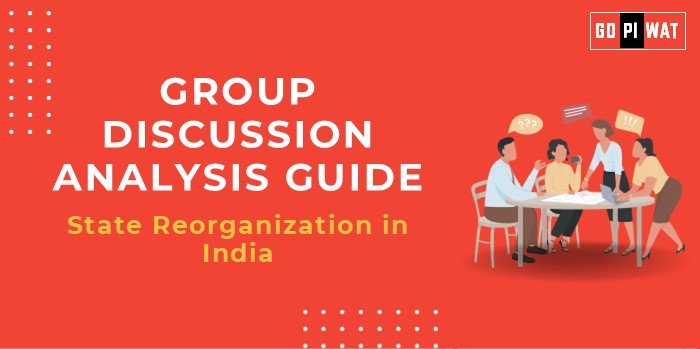📋 Group Discussion (GD) Analysis Guide: Should India Create Smaller States?
🌐 Introduction to the Topic
- 📖 Opening Context: “India, with its vast population and diversity, operates as a federal system with 28 states and 8 union territories. Discussions on the optimal number of states have gained traction amid debates about administrative efficiency, regional representation, and governance.”
- 🌍 Topic Background: India’s current state structure was primarily established after the States Reorganization Act of 1956, based on linguistic lines. Calls for new states like Vidarbha and Gorkhaland arise periodically, driven by aspirations for better governance and representation.
📊 Quick Facts and Key Statistics
- 👥 Population per State: Average of 47 million people per state, compared to the global average of 20 million.
- 📊 Economic Disparity: States like Maharashtra contribute 15% of GDP, while Bihar contributes 2.8%.
- 📈 New States: Last reorganization in 2014 (Telangana) showed GDP growth of 13.9% (2014–2019).
- 🛠️ Administrative Load: UP has over 200 million people, larger than most countries.
🤝 Stakeholders and Their Roles
- 🏛️ Central Government: Decides on state bifurcation and oversees implementation.
- 🏢 State Governments: Advocate for or oppose division based on political and economic interests.
- 👥 Citizens: Push for representation, resource allocation, and cultural preservation.
- 📚 Experts and Academicians: Provide insights on administrative and fiscal feasibility.
🏆 Achievements and Challenges
✨ Achievements:
- ✅ Economic Growth: Telangana’s bifurcation showcased focused development.
- 📋 Improved Representation: Smaller states like Uttarakhand show enhanced governance efficiency.
- 🌍 Local Identity: Division fosters the preservation of cultural and regional identities.
⚠️ Challenges:
- 🌊 Resource Allocation: Redistribution of water, revenue, and natural resources leads to disputes (e.g., Krishna River).
- ⚖️ Political Complexity: Risk of excessive centralization or politicization of demands.
- 🌏 Global Comparisons: US (50 states, population 331 million) achieves decentralized governance successfully, but Nigeria’s 36 states face inefficiency.
💡 Structured Arguments for Discussion
- 📢 Supporting Stance: “Smaller states lead to better governance, evident from examples like Telangana’s economic growth.”
- ❌ Opposing Stance: “Creating new states may intensify resource disputes, increasing administrative costs.”
- ⚖️ Balanced Perspective: “While smaller states can boost governance, the success depends on strategic planning and execution.”
📌 Effective Discussion Approaches
🎯 Opening Approaches:
- 📊 “UP’s population exceeds Brazil, yet it functions as a single administrative unit.”
- ❓ “Can India adopt a model like Estonia’s to simplify bureaucratic functions?”
🔄 Counter-Argument Handling:
- 📖 Highlight global examples and propose frameworks like autonomous regions as alternatives.
- 🛠️ Cite successful reorganizations, like Telangana, to demonstrate potential benefits.
📚 Strategic Analysis of Strengths and Weaknesses
- 💪 Strengths:
- 📋 Better governance.
- 📈 Focused development.
- 📉 Reduced administrative burden.
- ❌ Weaknesses:
- 💵 High costs of reorganization.
- ⚖️ Potential political instability.
- ✨ Opportunities:
- 🌐 Enhanced federalism.
- 📊 Creation of regional economic hubs.
- ⚠️ Threats:
- 🛑 Ethnic tensions.
- 📉 Long-term administrative complexity.
🎓 Connecting with B-School Applications
🌐 Real-World Applications:
- 📊 Use in federal governance projects and operations management.
❓ Sample Interview Questions:
- ❓ “Can smaller states address India’s socio-economic disparities?”
- 💡 “Discuss the administrative challenges of dividing a state like UP.”
📈 Insights for Students:
- 📖 Emphasize policy analysis, resource management, and regional development studies.


